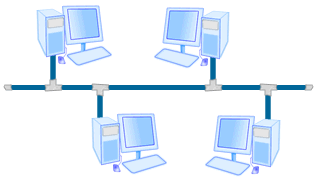Networking Guide : Network Topologies
Topology is the physical configuration of a
network, that is how nodes in a network are connected to one another.
Five topologies are explained in this guide, i.e. bus, star,
cluster tree, ring, and mesh.
In bus topology, all nodes are
connected to a central cable which is called a bus. A message
(signal) that is sent by a node travels along the bus through all
other nodes. When the signal passes by a node, the node checks its
destination address. If it matches the node's address, it
processes the signal. Otherwise, the signal will continue its
travel until it finds its destination.
Failure in one node doesn't affect the other nodes. However if the
central cable breaks, the network will stop working. Bus network
implementation is relatively cheaper.
Ethernet
10Base2 and
10Base5 networks are
examples of LAN technology that uses bus topology. But
they are rarely used today.

Picture: Bus Topology
Each node is connected to a bus.
page 2 : star and
cluster-tree
page 3 : ring and mesh
|